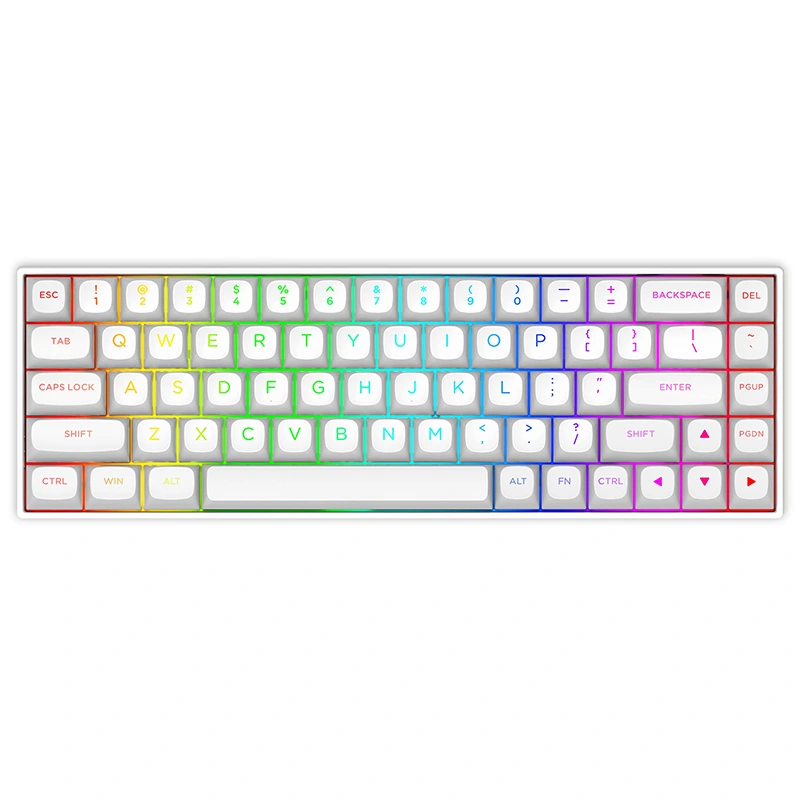What are the qualities of a mechanical keyboard?
2024-06-14
Mechanical keyboards are known for their distinct characteristics that differentiate them from membrane or scissor-switch keyboards. Here are the primary qualities of a mechanical keyboard:

1. Switch Type
- Mechanical Switches: Each key on a mechanical keyboard uses a mechanical switch that typically consists of a housing, a spring, and a stem. These switches are more durable and provide a consistent typing experience.
- Variety of Switches: Mechanical keyboards come with various types of switches (e.g., Cherry MX, Razer, Romer-G) that offer different tactile feedback and actuation forces. Common switch types include linear (smooth keystroke), tactile (a noticeable bump), and clicky (audible click).
2. Durability
- Longevity: Mechanical keyboards are known for their durability, with many switches rated for tens of millions of keystrokes, far exceeding the lifespan of membrane keyboards.
- Robust Construction: The overall build quality of mechanical keyboards is generally superior, often featuring robust materials like metal backplates and high-quality plastics.
3. Typing Experience
- Tactile Feedback: Mechanical switches provide a distinct tactile feedback that can enhance the typing experience and reduce typing errors.
- Consistent Keystrokes: The actuation force and travel distance of keys are consistent, leading to a more reliable and satisfying typing experience.
4. Customizability
- Keycap Replacement: Keycaps on mechanical keyboards are easily replaceable, allowing for customization with different colors, shapes, and materials.
- Switch Replacement: Some mechanical keyboards allow for hot-swapping switches, enabling users to change the switches without soldering.
5. N-Key Rollover and Anti-Ghosting
- N-Key Rollover (NKRO): Mechanical keyboards often support NKRO, allowing multiple keys to be pressed simultaneously without losing any keystrokes.
- Anti-Ghosting: Ensures that all key presses are registered correctly, even during fast typing or gaming sessions.
6. Programmability
- Macro Functions: Many mechanical keyboards come with programmable keys that allow users to assign complex macros or custom functions.
- Custom Lighting: RGB mechanical keyboards offer extensive lighting customization, with programmable lighting effects and per-key illumination.
7. Aesthetics
- Design Variations: Mechanical keyboards come in a variety of designs, including different layouts (e.g., full-size, tenkeyless, 60%), colors, and form factors.
- Backlighting: Many mechanical keyboards feature backlighting, which can range from single-color to full RGB, adding a visual appeal and aiding in low-light usage.
8. Sound
- Auditory Feedback: The sound produced by mechanical switches varies depending on the type. Clicky switches like Cherry MX Blue produce a loud, satisfying click, while linear switches like Cherry MX Red are quieter.
9. Ergonomics
- Ergonomic Design: Some mechanical keyboards are designed with ergonomics in mind, featuring adjustable heights, wrist rests, and split designs to reduce strain during prolonged use.
10. Performance
- Responsiveness: Mechanical keyboards are generally more responsive, making them popular among gamers and professionals who require precise and fast inputs.
- Actuation Force: The actuation force required to register a key press can be tailored to the user's preference, with options ranging from light to heavy.

